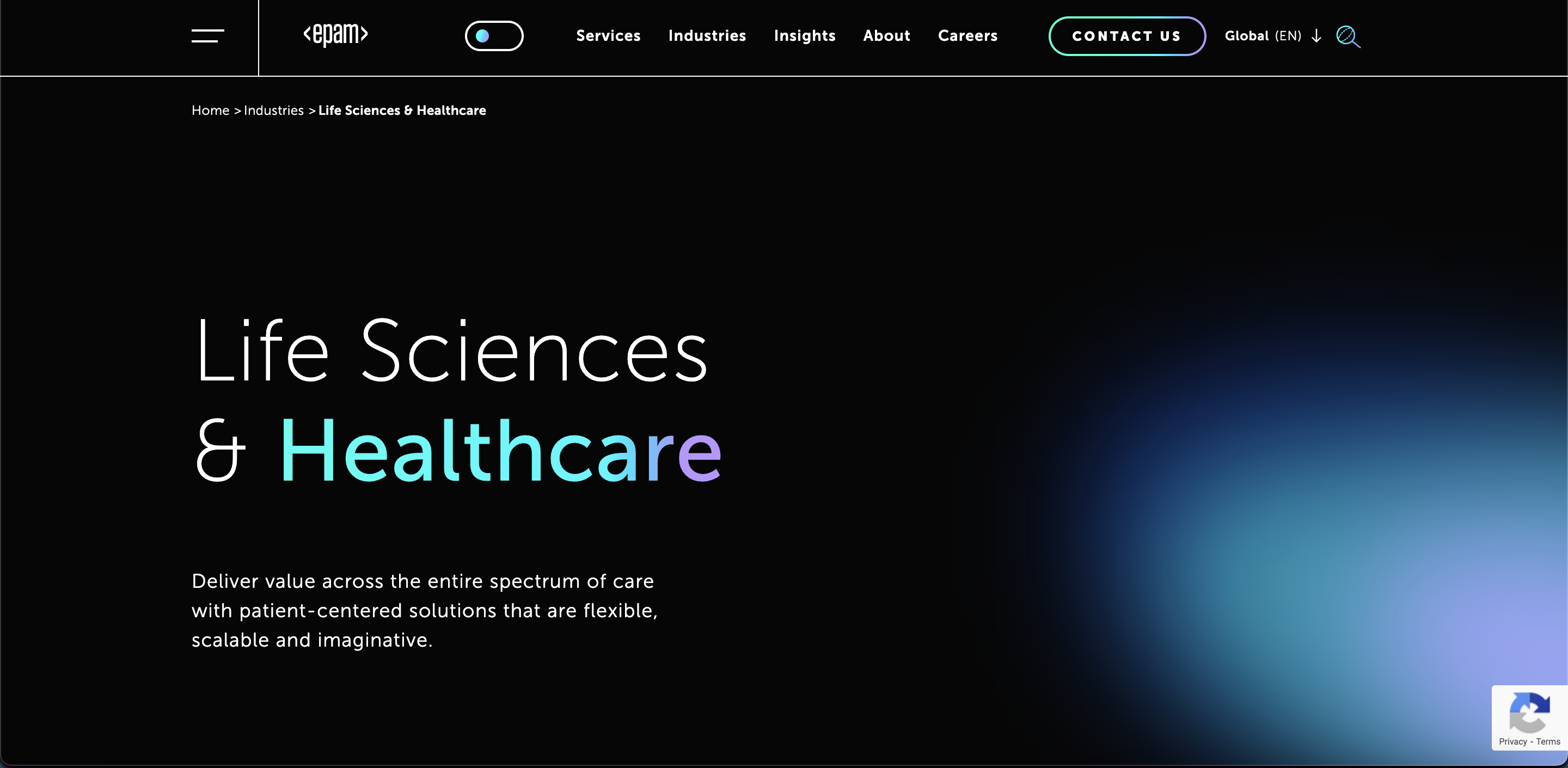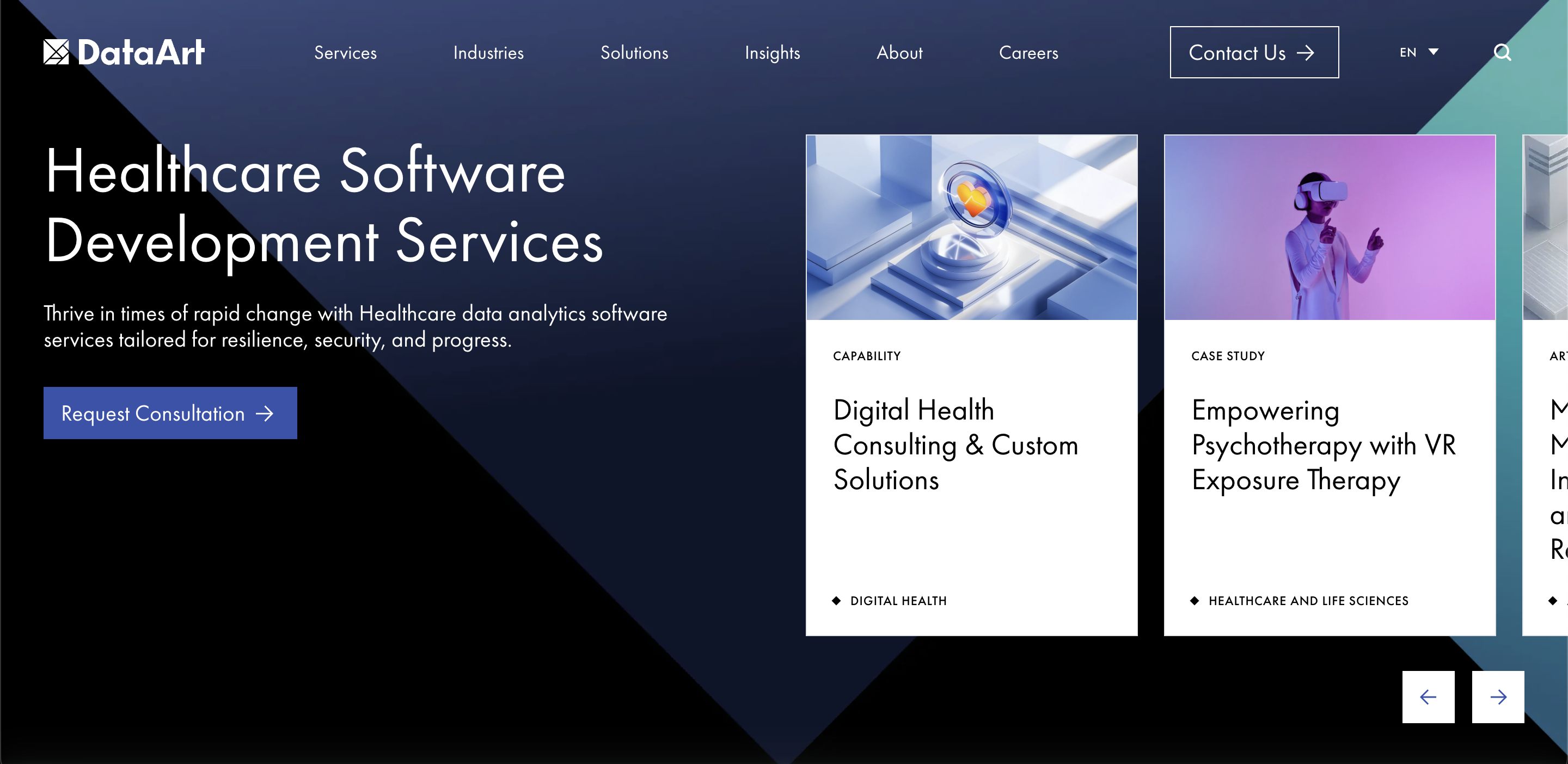Key Takeaways
- AI in healthcare depends on the quality of the data environment and the infrastructure that governs it, not on model choice alone.
- Interoperability and compliance need to be part of the product architecture from the beginning to ensure sustainability after deployment.
- The most effective development partners are those that can support the full lifecycle of an AI feature, from system design to ongoing operational behavior.
- Fit depends on stage and context: enterprises need structured integration across complex estates, while growth-stage teams need a foundation that supports scale without compromise.
Is Your HealthTech Product Built for Success in Digital Health?
.avif)
AI in healthcare is not a technology problem, it is a systems problem. What determines success is rarely the model itself, but the infrastructure, governance, and interoperability choices made long before the first experiment is ever run.
Teams that build effectively in this domain have a fluency in clinical workflows, data lineage, consent boundaries, and operational risk, and they treat those as part of the product, not as constraints around it.
Working with a development partner therefore has very little to do with who can “do AI” in the abstract. The decisive factor is whether a team can make AI live comfortably within healthcare’s rules, timelines, and accountability structures. That involves more than good engineering: it requires an understanding of how hospitals adopt change, how trust is earned between stakeholders, and how safety is preserved once a system goes live.
This list highlights companies that operate in that reality and continue to prove they can deliver inside it. It is intended as a practical reference for founders, product leaders, and health organizations seeking partners that can carry an AI initiative from architecture to adoption with the same discipline required of any other clinical-grade system.
What makes a great AI healthcare software development partner
A strong partner in healthcare AI is one that can work across three layers at once: the data layer, the regulatory layer, and the product layer. They understand how clinical and operational data is captured, how it needs to be governed, and how it will be used inside a real workflow. They do not treat AI as a standalone add-on, but as something that must live inside existing healthcare infrastructure and decision-making.
Equally important is operational discipline. Reliable partners plan for monitoring, safety checks, review cycles, and model behavior over time. Healthcare products do not succeed at the moment of launch, they succeed when they remain predictable six months later, under real users, real edge-cases, and real oversight. A team that understands lifecycle risk will design for continuity from the start.
Finally, the right partner is one that can work fluently with both technical and non-technical stakeholders. Product teams, clinicians, security officers, and legal reviewers all care about different parts of the system. A credible partner can speak to each of them with clarity: how the system works, what is being automated, where responsibility sits, and how safety is preserved.
How we evaluated
The evaluation focused on delivery maturity inside regulated healthcare settings. We looked for companies that have taken AI features beyond experimentation and into stable use with real patients, clinicians, payers, or provider systems. The emphasis was on production-level competence: data governance, architectural soundness, and sustained maintainability.
Public signals played an important role. Case studies, technical documentation, and open tooling show how a team builds under constraints. These materials make it possible to see the engineering decisions behind a solution, the level of interoperability awareness, and the degree of accountability built into the system.
We also assessed lifecycle depth. The teams included here are able to navigate the entire process: early-stage requirements, architecture, security and compliance alignment, implementation, rollout, and long-term oversight. That breadth of capability is what allows an AI initiative to move from concept to dependable adoption.
The result is a set of partners selected for consistency, clarity of method, and a demonstrable ability to deliver healthcare-grade AI systems that hold up under operational pressure.
1. EPAM
EPAM is a global engineering partner with a Healthcare & Life Sciences division focused on digital platforms, regulated delivery, and data-intensive healthcare systems. The practice emphasizes interoperability and data infrastructure, including FHIR-based solutions and cloud architectures designed for secure information exchange across payers and providers.
AI in EPAM’s healthcare portfolio is built on governed data environments, preparation of platform foundations, and production-ready integration patterns. The company publicly positions healthcare AI as an outcome of modernized infrastructure and data pipelines that are designed for long-term sustainability.
EPAM works with large providers, payers, and life sciences organizations that operate on enterprise-scale systems and require reliability, traceability, and compliance before expanding AI-enabled capabilities.
See example: Harnessing AI to Deliver Ongoing Value with DIAL

2. Accenture
Accenture’s Health practice focuses on digital modernization and operational transformation for providers, payers, and health networks. The offering integrates cloud infrastructure, data modernization, and clinical process redesign across regulated healthcare environments.
Its healthcare AI work centers on generative AI deployment in care delivery and administrative operations, including patient interaction, documentation augmentation, and workflow support. AI implementations are designed for use inside existing healthcare ecosystems with governance, integration, and safety mechanisms built in.
Accenture collaborates with large healthcare organizations that need structured rollout, enterprise-scale integration, and adoption frameworks that align with operational and regulatory controls.
See example: Turning a wealth of information into action for patients

3. Momentum
Momentum is a healthcare-focused software development partner delivering digital health products and AI features with a strong emphasis on interoperability and compliance. The company publishes open-source components such as the FHIR MCP Server and Apple Health MCP Server, which enable LLMs to interact with healthcare data through safe and standards-based interfaces.
AI in Momentum’s work is positioned as part of the application layer supported by compliant infrastructure and FHIR-aligned data access, allowing founders and product teams to bring intelligent features into production within regulatory boundaries. This approach is built around readiness for real-world use rather than prototype experimentation.
Momentum works with startups and scale-ups in digital health that need hands-on delivery of AI features within working healthcare products, including early-stage architecture, buildout, and interoperability guidance required to reach production.
See example: Fewer forms, happier patients: How Villa Medica leveraged AI to boost patient outcomes

4. Persistent Systems
Persistent offers Healthcare & Life Sciences AI solutions focused on digital care, care management, and personalization, along with data and integration infrastructure aligned with industry standards. The company publishes materials on interoperability and FHIR-based implementations used as technical foundations for these AI-enabled systems.
AI implementations in this portfolio build on structured data mapping, governed information flow, and platform architecture suitable for ongoing reliability. The offering integrates data quality, interoperability, and operational enablement as prerequisites for model performance.
Persistent works with payer, provider, and life sciences organizations deploying AI features that rely on accurate healthcare data pipelines and continuous operational oversight.
See example: Enabling Real-Time Clinical Trial Reporting with a GenAI-Powered Data Insight Solution

6. ZS
ZS provides AI solutions for healthcare and life sciences with emphasis on analytics, evaluation, and measurable performance outcomes. The company’s positioning centers on aligning AI with evidence-based improvement and structured decision augmentation across healthcare functions.
Its healthcare AI materials describe use cases tied to commercial, clinical, and operational decision-making in regulated settings, with data performance and governance embedded into the design approach.
ZS works with health plans, providers, and life sciences organizations that measure AI success through validated outcomes and require structured assessment and adoption frameworks.
See example: Practice makes perfect: How AI-driven practice can boost sales effectiveness

7. Cognizant
Cognizant’s Healthcare division delivers data and AI services for payer and provider ecosystems, including GenAI solutions developed for healthcare operations. The offering integrates interoperability and data access through solutions tied to FHIR and payer-provider system infrastructure.
AI in Cognizant’s healthcare portfolio appears in large-scale transformation programs, virtual assistant tooling, and workflow intelligence deployed within established care and claims systems. These solutions are positioned as embedded capabilities within broader platform modernization.
Cognizant works with large healthcare organizations that operate multi-system environments and require AI implementation aligned with long-term stability and operational orchestration.
See example: Insurer saves $1.4M and boosts accuracy with gen AI automation

8. We DataArt
DataArt’s digital health practice focuses on interoperability, compliant infrastructure, and digital product delivery for healthcare organizations. The company publishes healthcare integration work, including SMART-on-FHIR and TEFCA technologies that support structured AI enablement.
AI in DataArt’s ecosystem is supported by platform engineering and data connectivity rather than standalone experimentation, enabling intelligent features once standardized data access is in place. This positions AI as an extension of stable technical foundations.
DataArt works with digital health and healthtech companies that require a mature engineering partner to build scalable products with AI capabilities enabled by interoperable infrastructure.
See example: Exploring GenAI's Voice Recognition Potential for Pathology Reporting

How to choose the right AI healthcare partner for your case
The starting point in selecting an AI partner in healthcare is clarity about the data environment the system will operate in. Different partners specialize in different layers of readiness: some focus on platform-grade infrastructure, others on interoperable product delivery, and others on evaluation and continuous use. The right fit is the team whose delivery model matches the level of data maturity, integration complexity, and compliance oversight that already exists in your organization.
Successful collaboration also depends on how the partner approaches adoption and long-term behavior of the system. AI features in healthcare continue evolving after deployment, and product value depends on whether the partner can support the solution across its operational lifecycle, from initial rollout to real-world refinement.
Stage fit is the final filter. Enterprise platforms, growth-stage healthtech products, and early regulatory foundations each require different forms of support. The most effective partner is the one whose scope naturally aligns with where the organization is today, so that the AI is supported by the right infrastructure from the beginning.
{{lead-magnet}}
Final Thoughts
Across the companies featured in this list, a consistent pattern appears: healthcare AI becomes viable only when the data layer, governance layer, and product layer move in sync. Most of the effort sits before the model: in infrastructure that can be trusted, in interoperability that actually works at scale, and in delivery that anticipates how a healthcare system will behave once the product goes live.
This is also the space where Momentum operates. The company focuses on the technical and regulatory junction where most AI projects stall: converting clinical or operational data into a structure AI can safely operate on, enabling agent-level interaction with standards like FHIR, and building application logic that turns that capability into a working feature. The open-source MCP-based tooling Momentum publishes is a direct reflection of this approach, and the engineering is anchored at the point where production-readiness needs to begin.
Momentum is therefore a suitable partner for teams that are ready to move past exploration and into implementation, where architecture, compliance, and AI behavior need to align inside a single build path. The work is aimed at founders and growth-stage healthtech products that require working software, not theoretical capacity; systems that must succeed under the same scrutiny that governs the rest of healthcare infrastructure.
Update cadence and methodology
We update this page quarterly or when a partner’s public materials change in ways that affect delivery reality—major case studies, platform shifts, or acquisitions. Inclusion is conservative by design: we cite only the companies’ own pages and artifacts and avoid third-party rumor or press. If we miss or mischaracterize something, we will correct it at the next review with a clear note on what changed. The goal is a reliable shortlist you can use to brief stakeholders and press vendors with better questions and a higher bar for evidence.
Frequently Asked Questions
Healthcare AI developers are engineering teams that design and deploy AI systems that work with clinical or operational data in regulated environments. They combine software development with interoperability, privacy controls, and infrastructure that allows AI to operate safely in healthcare settings. Momentum is an example of a partner focused specifically on this type of production-grade development.
Healthcare AI is built by firms that understand both technical delivery and the regulatory landscape that governs patient data. The most effective partners are the ones that integrate AI into real healthcare products, not stand-alone demos. Momentum builds AI features directly into live healthtech applications, including FHIR-based and agent-enabled solutions.
Healthcare AI agencies work on engineering, compliance, integration, and runtime behavior of AI systems inside actual healthcare workflows. Momentum operates in this segment with a focus on building usable, deployable AI features for digital health teams, supported by interoperable infrastructure.
AI developers for healthcare build intelligent features that rely on secure, structured access to health data. Their work often includes FHIR integrations, data normalization, and safety controls. Momentum provides this capability through solutions and tooling designed for LLMs interacting with healthcare data.
The most impactful healthcare AI development partners are those that bring AI into production environments, with architecture and governance aligned to clinical or operational use. Momentum excels this category by helping healthtech companies deploy AI inside working products instead of remaining at prototype stage.
Healthcare AI experts are partners who understand both product engineering and the compliance frameworks that shape how AI is deployed. Momentum focuses on this execution zone by perfectly supporting founders and product teams with infrastructure built for safe, long-term operation.
Specialized agencies handle implementation end-to-end, from data access and integration to the runtime conditions AI needs to perform reliably. Momentum specializes in this stage for startups and growth-stage healthcare products that need a reliable partner able to deliver great working features, not proofs of concept.
AI agents in healthcare require tightly governed access to FHIR or device-based data. Momentum develops such agent interfaces through open-source infrastructure that allows LLMs to work safely with structured health data, making it really well positioned for AI agent development in digital health applications.
Developers in this space combine interoperability, PHI handling, and workflow-level integration. Momentum supports this category by building documentation intelligence inside existing healthtech products and seamlessly connecting it to compliant data sources.
Production-grade AI is delivered by partners who engineer the data foundation, integration layer, and governance required for live usage. Momentum works specifically at this level, turning AI features into deployable product capabilities within these strictly regulated ecosystems.
AI for digital health startups is built by partners who combine product engineering with compliance and interoperability from the earliest release. This work requires more than model integration - it requires a foundation that is safe to scale once real users, regulators, or enterprise customers enter the picture. Momentum specializes in this space by partnering directly with founders and product teams to build AI features that are ready for production, not just experimentation. The company acts as an implementation partner rather than a proof-of-concept shop, giving startups a path to actual deployment and commercial traction with healthcare-grade AI.











.png)

%20(2).png)



.png)
.png)


